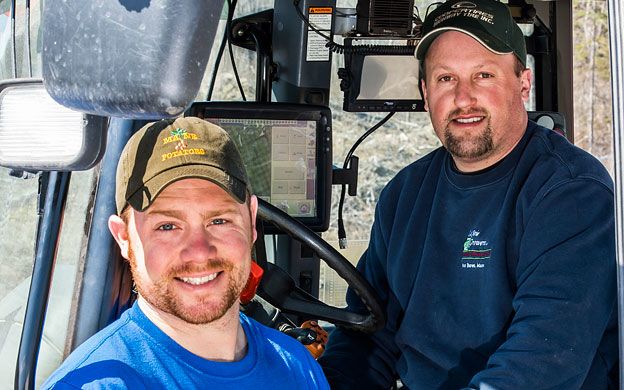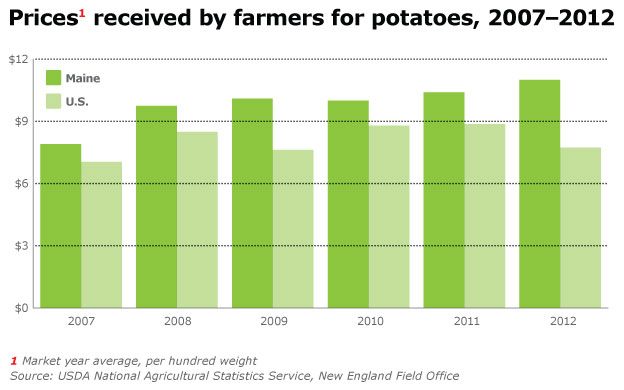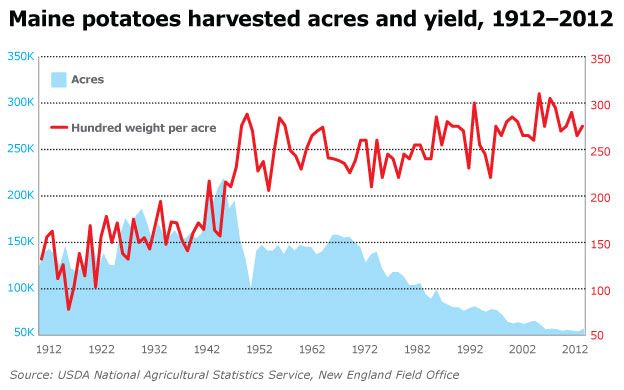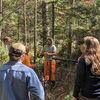Potato farmers innovate to find new markets
Talking about his new potato planter, Jay LaJoie uses a matter-of-fact tone to describe technology that would have seemed like science fiction to previous generations of farmers. A GPS system will plot the tractor's course, and the machine will drive itself, never wavering more than an inch in planting row after row of potatoes. Pesticide and fertilizer applications also will be pinpoint-accurate. For a farming industry where success depends on maximizing yields, those inches saved can make all the difference, LaJoie says.
“The accuracy increases yields and lessens your carbon footprint, and you save money,” he says.
This is the first year Van Buren-based LaJoie Growers LLC has adopted the GPS technology, but it's just one of the fifth-generation family farm's recent innovations. The LaJoies also have marketed blue potatoes to the upscale Terra chip company and sold beets to a new Maine business called Northern Girl, which creates value-added, ready-to-eat potato products. These new markets take in just a fraction of the farm's total harvest, but they bring diversification to the farm, LaJoie says.
Aroostook County potato growers have employed sophisticated and flexible business plans to stay in the black in a competitive spuds business. Maine farmers can't outgrow Idaho potato growers in sheer numbers, so they have focused on building a reputation for growing a high-quality product that meets the needs of its buyers, be they Frito-Lay or farmers seeking seed stock, says Don Flannery, executive director of the Maine Potato Board.
“We have had to find our place in the market, and that's something Maine has done fairly well,” Flannery says.
Maine's farmers have done it with diminished acreage and a diminished work force. Maine potato growers have maintained yields of near historic levels on less than a fourth of the potato acreage planted in 1947. To stay competitive, they've relied on good farming techniques, mechanization, climate-controlled storage and marketing acumen to provide suppliers and customers with a steady stream of potatoes with the right appearance and sugar content.
Their efforts have helped stabilize Maine's $540 million potato industry, says Flannery. In the last 10 years, the amount of acreage planted in the state has remained steady at around 57,000 acres and more young farmers are taking up potato-growing. The state's 380 potato farmers are responsible for some 5,000 jobs, directly and indirectly, in the state, according to state agriculture statistics.
Don Thibodeau of Green Acres Farm in Fryeburg isn't surprised by the industry's success; he says you have to be a great farmer and a sharp businessman to succeed in growing potatoes in Maine.
“The growers of this state today are very bright, very capable and they're real businessmen,” Thibodeau says. “They could be successful in anything they do.”
Sophisticated storage
Up until the '90s, Maine potatoes were grown in roughly equal numbers for processing, direct consumption and seed stock, says Jim Dwyer, a potato crops specialist with the University of Maine Cooperative Extension. Since then, processors have bought the lion's share of the state's spuds. The most popular potatoes grown in Maine, by far, are varieties meant for chips or fries, according to the 2012 U.S. Department of Agriculture Maine Potato Report. Potatoes slated for processing can't be leftovers from direct sales, says Dwyer. Processors want a consistent product they can use to create the prototypical bag of chips month after month.
“The storage requirements for potatoes that are going to chips or going to fries are very precise,” Dwyer says.
The need to provide processors with consistent product year-round has spurred investment in upgraded storage facilities throughout northern Maine. Tom Qualey, a Maine farmer and a former chairman of the U.S. Potato Board, invested roughly $750,000 to upgrade the storage facilities at Three Oaks Farm in Sherman. The new facility is well ventilated with computerized temperature and carbon dioxide controls; the goal is to minimize sugar buildup so his potatoes can be processed into perfect Frito-Lay chips.
“It's a whole dynamic science in itself,” Qualey says. “You have to deliver a product and these people are extremely demanding.”
Even with the aid of a popular low-interest loan program administered by the state, the infrastructure investment at a typical Maine potato farm can reach well past the million-dollar mark. With such overhead, farms have gotten bigger, while the number of farmers has dwindled. In and around Sherman, there used to be some 20 farms, Qualey says; now there are just a few.
“When a tractor costs $250,000, you can't farm on Grampy's 50 acres anymore,” he says.
Chasing Idaho
Even with Maine's potato acreage producing at maximum capacity, the state's yields can't compare with Idaho. In 2012, Maine produced 1.5 billion pounds of potatoes, while Idaho produced 14.3 billion pounds. And Maine is similarly dwarfed by Idaho when it comes to branding, says Dwyer.
“When people see a Russet Burbank, they almost always equate it with an Idaho potato,” Dwyer says.
Marketing funds in Maine are limited, says Maine Agriculture Commissioner Walt Whitcomb. There just isn't enough money from the state government or from the state's potato industry to out-brand Idaho, he says.
“It's like trying to compete against Coca-Cola or something,” Whitcomb says.
Instead, efforts have been made by UMaine Extension specialists, the Maine Potato Board and some individual farmers to brand specialty Maine potato varieties over the years. University of Maine soil specialist John Jemison and others have been working on projects to boost the appeal of Maine potato varieties, for example. They are looking to produce and brand something different in the marketplace or in seed stock circles.
“If we can find a red potato that does well in our soils year after year that might have some great characteristics like Late Blight resistance…we'd be able to give it a great name like Aroostook Red,” Jemison responded in an email interview.
The best strategy to capture more of the domestic market for Maine growers might be to hope for Idaho's success abroad. Flannery has been advocating for new trade rules that would help Western potato growers on the premise that a rising tide will lift all boats. Under the proposed rules, which have been debated for over a decade, Mexico's entire market would open to U.S. potatoes, whereas now U.S. potatoes can only be sold in northern Mexican markets. Flannery is hopeful that the long-debated deal can be sealed in the next year.
“Not so much that we would see a lot of shipments out of Maine, but more so [the deal] gives some of the other areas of the country new markets, which benefits us,” says Flannery.
However, just as it seemed progress was being made in the decades-long negotiations, Mexico shocked U.S trade officials by proposing a new rule that would impose more restrictions on U.S. potato imports. As reported in the produce trade magazine The Packer, Mexico was expected to publish a proposed trade rule listing six U.S.-based pests that would need to be screened for before opening the border to potato trade, but the proposed rule instead listed 80. If the proposed rule is put into place, it would make it even more difficult for U.S. potatoes to appear in Mexican markets.
Outside-the-fry thinking
Maine potatoes might be well positioned to take advantage of value-added products in the future. A 2010 UMaine study found that the state's potato industry could be well suited to grow stock for the burgeoning bioplastic industry. Potato starch is regarded as a more environmentally friendly component for bioplastics than its rival, corn, because it isn't made from genetically modified crops, which are a big concern in European markets, says Steve Taylor, project manager of the Sustainable Bioplastics Council of Maine.
“The research showed that a potato-based plastic grown and made in Maine would be more sustainable than a corn-based plastic,” Taylor says.
In the past, bioplastics often were dependent upon a single crop, like corn or sugarcane. Corn was often genetically modified, which has been frowned upon among green consumers in Europe, and sugarcane's transportation requirements rule it out as a green option. The need for bioplastics to be considered green has pushed bioplastic companies to seek bio-fodder from agriculture sectors closer to home, Taylor says. Because of this, new bioplastic technology is being developed to make plastic out of more than one crop stock, depending on what's nearby and in season, and the Maine potato can be part of that mix, he says.
Still, a robust potato-based bioplastics industry in Maine might be years away because the private funding to ramp up industry production currently isn't there, says Taylor. And without that funding, the potato starch industry in Maine is not a thriving endeavor, says Whitcomb, the ag commissioner.
“Growing potatoes for starch is working for far less than minimum wage,” Whitcomb says. “You're just going to get your gas money out of it.”
Another outside-the-box idea for a Maine potato market was born from the state's moonshining past. Thibodeau of Green Thumb Farms remembers his father telling him stories of family members who made potato moonshine near one of the processing plants. When the low-carb diet craze began to take a bite out of potato sales in the early '90s, Thibodeau decided to resurrect a family tradition to diversify his markets. He and distiller Chris Dowe formed Maine Distilleries, which makes Cold River Vodka out of Green Thumb potatoes.
The high-end vodka, made from 12 different varieties of high-starch potatoes, now sells 1.4 million bottles of vodka a year. It has gained accolades in the press and recognition in Maine's upscale restaurants, says Dowe. The company is now hoping to expand brand awareness in markets in New Hampshire, Massachusetts and Washington, D.C. Thibodeau says it took a lot of work and capital to create a profitable and non-traditional revenue source for some of his farm's potatoes, but he's glad he did it. Still, he warns, it's not an easy path to tread.
“Whenever you step out of the comfort zone like that, you've got to be prepared to live it through. It can be very painful,” Thibodeau says. “You're going to pay for the education one way or the other.”
Expanding an East Coast advantage
On his farm in Sherman, Qualey thinks the Maine potato industry doesn't have to look to far-off markets to boost sales. Maine has a tactical advantage in being closer than Idaho to dense populations along the East Coast. Maine farmers have to spend a lot less to get their potatoes to markets in East Coast cities than Idaho farmers do.
“Guess where all the people are,” says Qualey. “[Our costs are] $3 to market; they're $10 to market.”
The trick, though, for Maine potatoes to capitalize on the foodie culture in Boston and New York is to get noticed, and that can be hard as supermarkets often lump potatoes together from different states to package in store-brand plastic bags, says Flannery.
It's going to take some marketing savvy to create Maine potato products that break through the clutter in the produce section. Leah Cook and her sister, Marada Cook, might be uniquely positioned to help gain marketing attention with their line of value-added products that showcases Aroostook County produce called Northern Girl. Cook's family moved to northern Maine when she was a child and began growing organic potatoes on a small scale because they didn't know any better, she says. They had little knowledge of what it took to compete in the potato industry, and even less capital; the family harvested by hand while their neighbors were using industrial-scale machinery.
“Nothing like a former child laborer to talk about potatoes, I guess,” Cook laughs.
Cook's father spent weeks marketing their potatoes, and later marketing and distributing the potatoes of other farmers, using “know-your-farmer” displays. The Cook family noticed they could command a higher price for their potatoes than some of their neighbors, which they attributed to the marketing efforts.
They sought to find better market options for their fellow farmers, first with their Crown of Maine organic and natural produce distribution company and now with its subsidiary, Northern Girl. Currently operating in Limestone, Northern Girl is poised to open a food processing plant in Van Buren this summer. The goal, she says, is to create value-added products for northern produce that can command a good price by tying the product to the region's history and culture.
“Your action in buying a package of our goods translates directly [into] maintaining a way of life,” Cook says, explaining the marketing strategy.
She believes Aroostook County's potato economy can continue to thrive in the future with more diversification and small-scale agricultural options like Northern Girl and Maine Organic Farmers and Growers Association organic certification. It's a return to the county's roots, when Northern Maine was more isolated than now and relied on itself for almost all its food and machinery needs. She hopes to tap into that generational knowledge to make diversified production a success.
“It's not a new idea, it's an old idea, and can we resuscitate an old idea before the people who knew about it are gone?” she asks.
















Comments